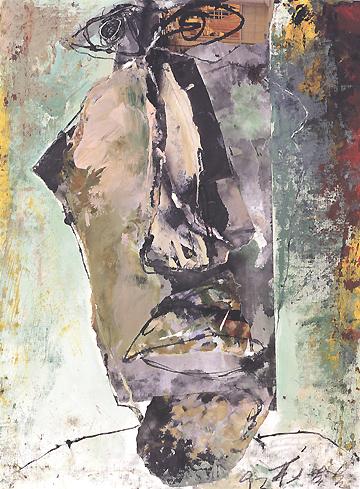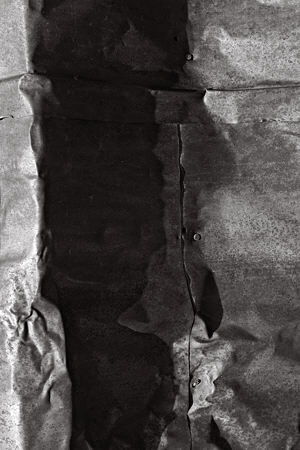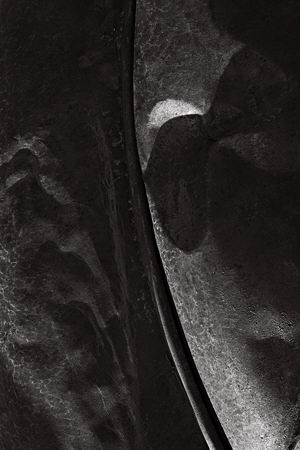An ideal blog post should be a nutritious snack like a granola bar: a little filling but not too heavy, containing a few sweet nuggets, and hopefully good for you. Well, you know how there’s usually a little spilled flour, a sticky spot of honey, and a few escaped raisins lying around after a cooking stint? And possibly a few items from earlier efforts? Welcome to my clean-up post.

One stray ingredient is one I deliberately left out of last week’s post on some modern Chinese abstract artists, for reasons of space and time. But Che Chuang’s painting of a head, shown above, struck a real chord with me. It reminded me strongly of two heads of my own that have appeared in these pages. The level of abstraction, original color, and even shape are not so very different.


Furthermore, that finding or fusing or confusing of the figure with a natural object (sheet metal qualifies if far enough returned to nature as to no longer serve its manufactured purpose) was very much the subject of Stone Soup, musings on Yellowstone rocks informed by Mark Stone’s essay series on figuration and abstraction, for which he’s preparing a new installment.

Continuing to add the miscellaneous ingredients at hand: on that same Yellowstone trip I photographed a pattern of lichens on a chunk of basalt that reminded me of a rider on a horse. That rock formation is known as Sheepeater Cliff, after the tribe that lived in the area. Just today at lunch, I came across an article about the Sheepeaters (by David Lewis in the Montana Pioneer) with the following quotation from the book Mountain Spirit, the Sheepeater Indians of Yellowstone (by L.L. Loendorf and N.M. Stone):
Like many other hunters and gatherers, the Sheep Eaters did not make a distinction between the natural and supernatural worlds. … As it was believed that spirits from the tree domains left their likenesses on rock surfaces in the form of petroglyphs, Sheep Eaters—especially men—often went to rock art sites to connect with their powers.
Which happens to dovetail ever so nicely with my current reading about Australian aboriginal art, fascinating for many reasons. I’m particularly interested in the relation of people (including the “artist”) to place, a question I’ve been pondering in my own fashion over at Along Sourdough Trail. I’m bound to have more on that topic later, but if you’re intrigued, my favorite place for it on the web is Deborah Barlow at Slow Muse (great writing in a slew of categories).
That about clears the counter; I’m leaving the kitchen sink as it is. Perhaps finding that all these disparate ingredients fortuituously fit together is not so surprising. Perhaps there’s greater unity in my flailings than previously suspected. Perhaps even something edible will come along eventually.

Interesting painting by Che Chuang. The eye to the left is looking into the world while the eye to the right is blind to the world, perhaps looking inwards. This notion first occurred to me viewing the pupils. On the left, the pupil is dark and turned outward like a lamp sitting on a stalk. On the right, looking through the transparent pupil, one sees a window or, if one wants to be dramatic, a door to a jail cell. This idea is further supported by the surroundings. The seeing eye to the left glances into the world, unobstructed. The blind eye to the right faces a wall.
On first glance, I took this painting to be a person upside down, with the neck being the head. It took a while to correct this impression and accept the face.
In your first photo, I see 3 faces, the large one looking to the right and two smaller ones, one on top of the other, looking to the left. Your second photo is unambiguous to my eye. In your third photo, the rider on a horse could be an American Indian with a yellow headdress.
Thus, it appears that the painting, once I accepted that it shows a head, is no longer ambiguous. In contrast, with two of your photos, my mind plays games, flipping from one interpretation into another.
Thanks for the link to the Slow Muse.
Steve:
Thanks for your cliffs notes.
I’m confused about the Sheepeaters: did they encounter their “petroglyphs” as something that somebody painted, or as happenstance then rendered by the Sheepeater mind into a form of significance? As you know, some scholars have theorized that the neolithic cave painters of Europe were guided in their imagery by the various irregularities in the cave walls and ceilings that reminded them of their primary visual fixations in the form of prey items. There is in each of us a propensity to see faces in things, serving some survival purpose and possibly a contributing factor in the development of a spiritualistic outlook. Like in the morning, upon awakening, I am likely to see entities appearing among the garments on the clothes rack and the drapes. Sorry, no pink elephants among them.
We college students discovered an issue in abstraction: you have to ambiguate. Nothing, we learned, could kill a good abstract painting like the presence of Aunt Bertha among the blobs and swirls. You just couldn’t get away with activating those centers in the viewer’s brain.
Jay,
I don’t know much about the Yellowstone petroglyphs, which I haven’t seen (I didn’t know before yesterday that they supposedly existed at Sheepeater Cliff). They may be so old that the Sheepeaters of recent centuries don’t know about their origins, or they might have been made by other groups. In the Southwest, there are a number of sites where old pictographs have been damaged by present-day inhabitants fearing their possible significance.
By the way, petroglyphs are incised in the rock, whereas pictographs are painted on. I’m not sure if the distinction was important for the makers; often both appear together.
I like the idea that someone on a vision quest at the cliff would conjure up images from their own mind, as prompted by rock features. I hadn’t heard about such a theory regarding cave art. It seems plausible, but hardly necessary.
Birgit,
That’s a very interesting observation about the eyes. I mainly found it peculiar how they are almost disconnected from the face. I also see echo eyes in a couple places elsewhere in the painting.
I haven’t made out the left-looking faces you see in my first photograph. I guess I would make a poor vision quester.